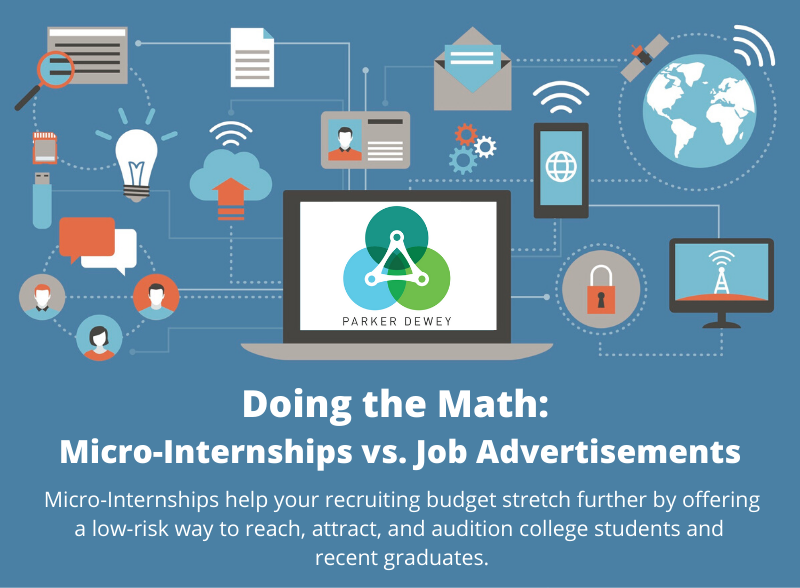
The Cost (in)Effectiveness of Job Ads
Let’s look at a day in the life of a recruiter in 2020.
You check your calendar to prep for the day, you email a response to an applicant that reached out to you yesterday afternoon, you make a phone call to the candidate that interviewed to share the good news about next steps, you make more coffee. Then somewhere in your day, you check for new applications that may have come in from LinkedIn, Indeed, and Workable.
You notice hundreds of resumes came through in the past month. Now it’s time to sort and review them all. You know that some of these candidates may not look good on paper, but they might be a perfect fit if given the chance to do the work. However, the value on paper is what makes the first impression. You’re not sure how effective job ads actually are to your recruiting efforts.
Enter, Micro-Internships; A cost-effective, mutually beneficial approach to recruiting. In this article, we’ll explore the reasons that Micro-Internships are a timely and cost-effective approach to placing the perfect candidate over traditional recruiting tactics.
Online job ads take resources
By resources we mean, time and money. The time and cost efficiency of both job ads and Micro-Internships differ greatly. The longer it takes for you to fill a position via job ads, the more you end up spending to get the right eyes to see the ad and to apply. In the meanwhile, these job ads are filtering out candidates based on factors that don’t exactly predict success, leaving out a wide range of college students and recent graduates who would have what it takes to fill that entry-level job. Time spent wisely? Maybe not.
Cost effectiveness of a Micro-Internship
Let’s go back to the obvious: Job advertising can be costly. After a big spend on ads, you may still have to rely on the hope of finding at least one qualified candidate to pick out. Plus, different positions attract an array of candidates. So you do your research and post the hard-to-fill positions very strategically to maximize your ad spend. Yet you end up spending more than you thought on the “hot job” you posted on Indeed.com because everyone is clicking, as your cost-per-click budget shrinks.
You may end up with three qualified candidates, but are now out of budget with a smaller stack of applications than you’d hoped for the amount that you spent on posting these job ads.
Let’s look at how the cost of a Micro-Internship can have optimal return on your investment. For an average project cost of just $400, each Micro-Internship provides:
- Nationwide access to college students and recent graduates
- An average of 10 applicants per project
- Ability to audition candidates year-round
Micro-Internship programs give college students and recent graduates the opportunity to add real work experience to their resume while demonstrating their skills to your company. Meanwhile, it helps you stretch your recruiting budget with a low-risk way to reach and attract viable candidates. That’s a win-win.
According to a 2019 Statista study, online job boards are the leading tool that students use to job hunt. However, the average cost of a sponsored job ads can cost between $50 a month to $495 for a 30-day listing period!
The cost to be visible to our network of students is: free.
Quality of candidates
Job ads also can’t guarantee that they bring the best candidate pool forward, which is something you may not know until later on in the recruiting process. The candidates applying to your job ads could be professionals that are looking for a new position or maybe someone who is not necessarily hard set on the position that your job ads are offering. You can’t know for sure if your job ads will produce satisfactory hires.
You want your recruiting efforts to prove successful. A recent Statista study shows that the leading channels in recruitment effectiveness are hiring managers and internal mobility. Micro-Internships provide the opportunity for a candidate who already has their foot in the door to move into a full-time position and has already gained the skills needed to work in that space.
More reasons to choose a Micro-Internship
As a recruiter, you’re well aware of the time and effort both you and your team are putting into matching candidates with the right job opportunity. You’re also aware that it can be tricky to create a solid pipeline of qualified talent on a set budget. The solution Micro-Internships offer is mutually beneficial as they allow low-risk opportunities that attract talent to the right roles, and vice versa.
Micro-Internships are successful because a company gets to see potential talent in action while valuable projects are moved forward. Moreover as a recruiter, you get: access to broader talent pools, to support diversity efforts, and increase awareness and conversion. Let’s talk about this.
Access broader talent pools: By looking beyond target schools, GPAs, and majors, you expand your reach to thousands of new candidates. The majority of these candidates are highly motivated and would opt in for remote work, offering even more accessibility.
Support diversity efforts: Over 80% of Career Launchers selected on Parker Dewey come from underrepresented populations. Approaching recruitment efforts through Micro-Internships enables access to a better variety of college students with grit, including those with disabilities.
Increase awareness and conversion: Micro-Internship programs offer your company early access to college students and provides insights into career pathways for early career professionals.
Read our guide to entry-level hiring to learn how to improve your job hiring strategy and increase job placement with Micro-Internships.
How Parker Dewey can help
Companies of all sizes and within any industry can opt in to use Micro-Internships with entry-level projects to target quality candidates. It’s a win-win situation when you can get talent through the door, to work on important projects while boosting their skill set, nearly risk free. The old-fashioned interview process cannot get more straightforward than someone with talent showing you what they can do, live.
See why companies, like Microsoft, expanded their Micro-Internship program to their recruiting efforts.




